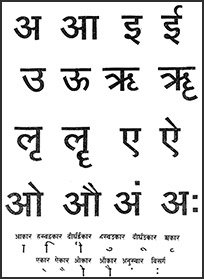Ekara, Ekāra, Ekarā, Eka-ra, Ēkarā: 11 definitions
Introduction:
Ekara means something in Buddhism, Pali, Hinduism, Sanskrit, Hindi, Tamil. If you want to know the exact meaning, history, etymology or English translation of this term then check out the descriptions on this page. Add your comment or reference to a book if you want to contribute to this summary article.
In Hinduism
Purana and Itihasa (epic history)
Source: Cologne Digital Sanskrit Dictionaries: The Purana IndexEkāra (एकार).—The 11th Manu from the 11th face of the fourteen faced deva of piśaṅga colour.*
- * Vāyu-purāṇa 26. 43.

The Purana (पुराण, purāṇas) refers to Sanskrit literature preserving ancient India’s vast cultural history, including historical legends, religious ceremonies, various arts and sciences. The eighteen mahapuranas total over 400,000 shlokas (metrical couplets) and date to at least several centuries BCE.
Vyakarana (Sanskrit grammar)
Source: Wikisource: A dictionary of Sanskrit grammarEkāra (एकार).—The letter ए; looked upon as a diphthong (संध्यक्षर (saṃdhyakṣara)) made up of the letters अ (a) and इ. The combination of the two constituent parts is so complete as cannot allow any of the two parts to be independently working for saṃdhi or any other operation with its adjoining letter; cf नाव्यपवृत्तस्य अवयवे तद्विधिर्यथा द्रव्येषु (nāvyapavṛttasya avayave tadvidhiryathā dravyeṣu) M. Bh. Śivasūtra 3 Vārt. 9.

Vyakarana (व्याकरण, vyākaraṇa) refers to Sanskrit grammar and represents one of the six additional sciences (vedanga) to be studied along with the Vedas. Vyakarana concerns itself with the rules of Sanskrit grammar and linguistic analysis in order to establish the correct context of words and sentences.
In Buddhism
Tibetan Buddhism (Vajrayana or tantric Buddhism)
Source: OSU Press: Cakrasamvara SamadhiEkāra (एकार) refers to the “letter E”, according to the Cakrasaṃvara Samādhi [i.e., Cakrasamvara Meditation] ritual often performed in combination with the Cakrasaṃvara Samādhi, which refers to the primary pūjā and sādhanā practice of Newah Mahāyāna-Vajrayāna Buddhists in Nepal.—Accordingly, “The letter E shape [e.g., ekāra-ākṛti], abode of strong essence, the womb space of the lotus, Therein the midst, a secret Vaṃ, a beautiful bowl, the origin of all one’s self, An abode of perfectly pure awakened omniscience, beautiful divine power, And I, innately pure, praise the highest pleasure, the innate heroic couple”.
Source: academia.edu: Elements of Newar Buddhist Art (EB)Ekāra (एकार) refers to “the letter e” (symbolizing Dharmodaya—“an inverted triangle symbolizing the female principle”) (Cf. Evam).—According to the Sādhanamālā no. 97, “Dharmodaya is akin to sky, and appears like the vowel e [Brāhmī script] because it has a wide upper section and narrow pointed lower section”.—Since this vulvate triangle resembles the vowel e in Brāhmī script it was also known as ekāra—“the letter e”. The interlocking double triangles motif was actually known to the Buddhist as evam or evaṃkāra, signifying non-dual unity of the female principle e and the male principle vam, a syllabic letter in ancient Indian scripts which was visualized as an upright triangle.

Tibetan Buddhism includes schools such as Nyingma, Kadampa, Kagyu and Gelug. Their primary canon of literature is divided in two broad categories: The Kangyur, which consists of Buddha’s words, and the Tengyur, which includes commentaries from various sources. Esotericism and tantra techniques (vajrayāna) are collected indepently.
Languages of India and abroad
Sanskrit dictionary
Source: DDSA: The practical Sanskrit-English dictionaryEkarā (एकरा).—Name of a daughter of Śiva, a deity.
Ekarā is a Sanskrit compound consisting of the terms eka and rā (रा).
Source: Cologne Digital Sanskrit Dictionaries: Cappeller Sanskrit-English DictionaryEkāra (एकार).—[masculine] the sound e.
Source: Cologne Digital Sanskrit Dictionaries: Monier-Williams Sanskrit-English DictionaryEkāra (एकार):—[=e-kāra] [from e] m. the letter or sound e, [Taittirīya-prātiśākhya etc.]
[Sanskrit to German]
Sanskrit, also spelled संस्कृतम् (saṃskṛtam), is an ancient language of India commonly seen as the grandmother of the Indo-European language family (even English!). Closely allied with Prakrit and Pali, Sanskrit is more exhaustive in both grammar and terms and has the most extensive collection of literature in the world, greatly surpassing its sister-languages Greek and Latin.
Hindi dictionary
Source: DDSA: A practical Hindi-English dictionaryEkāra (एकार):—(nm) the vowel e ([e]) and its sound; ~[rāṃta] (a word) ending in e ([e]).
...
Kannada-English dictionary
Source: Alar: Kannada-English corpusEkara (ಎಕರ):—[noun] a man of object nature or conduct.
--- OR ---
Ekāra (ಎಕಾರ):—[noun] the letter 'ಎ'.
--- OR ---
Ēkāra (ಏಕಾರ):—[noun] the letter 'ಏ'.
Kannada is a Dravidian language (as opposed to the Indo-European language family) mainly spoken in the southwestern region of India.
Tamil dictionary
Source: DDSA: University of Madras: Tamil LexiconĒkarā (ஏகரா) noun < English See ஏக்கர். [ekkar.]
Tamil is an ancient language of India from the Dravidian family spoken by roughly 250 million people mainly in southern India and Sri Lanka.
See also (Relevant definitions)
Partial matches: Eka, E, Kara, Ra.
Starts with (+22): Ekara Janem-Honem, Ekarada, Ekaradana, Ekaraj, Ekaraja, Ekaraja Jataka, Ekarajaka, Ekarajja, Ekarajni, Ekarajya, Ekarakama, Ekarakkha, Ekaraksha, Ekaram, Ekarama, Ekaramaram, Ekaramata, Ekaramga, Ekaramta, Ekarana.
Ends with (+90): Ahalekara, Ahallekara, Akekara, Alasugekara, Annekara, Arakekara, Aramanekara, Arekara, Asalekara, Asekara, Badagekara, Badigekara, Bagekara, Bajanekara, Balmekara, Balumekara, Bedekara, Bekara, Bemtekara, Besugekara.
Full-text (+58): Karatoya, Ekara Janem-Honem, Karottama, Karin, Karakara, Karapallava, Karakudmala, Karaprishtha, Karacchada, Karakosha, Karashakha, Karishtha, Karashotha, Karadaksha, Karavella, Kareta, Karakantaka, Karanihita, Karasthalin, Kariyas.
Relevant text
Search found 5 books and stories containing Ekara, Ekāra, Ekarā, Eka-ra, Eka-rā, E-kara, E-kāra, Ēkāra, Ēkarā, Egaraa, Aegaraa, Egara; (plurals include: Ekaras, Ekāras, Ekarās, ras, rās, karas, kāras, Ēkāras, Ēkarās, Egaraas, Aegaraas, Egaras). You can also click to the full overview containing English textual excerpts. Below are direct links for the most relevant articles:
Cidgaganacandrika (study) (by S. Mahalakshmi)
Verse 115 [Ambara Dvaya-rūpa of Śakti] < [Chapter 3 - Third Vimarśa]
Chandogya Upanishad (Madhva commentary) (by Srisa Chandra Vasu)
Jain Remains of Ancient Bengal (by Shubha Majumder)
Archaeological sites in West Midnapur District < [Chapter 4 - Distribution of Sites Yielding Jaina Remains]
Vernacular architecture of Assam (by Nabajit Deka)
The Bodo Vernacular Architecture < [Chapter 7]
Charaka Samhita (English translation) (by Shree Gulabkunverba Ayurvedic Society)
Chapter 1c - Fruits plucked with the Hand (kara-pracita) < [Cikitsasthana (Cikitsa Sthana) — Section on Therapeutics]